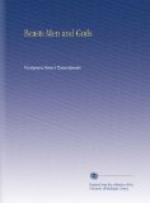Not far from the ruins in the lands of Hun Doptchin Djamtso there is a small lake which sometimes burns with a red flame, terrifying the Mongols and herds of horses. Naturally this lake is rich with legends. Here a meteor formerly fell and sank far into the earth. In the hole this lake appeared. Now, it seems, the inhabitants of the subterranean passages, semi-man and semi-demon, are laboring to extract this “stone of the sky” from its deep bed and it is setting the water on fire as it rises and falls back in spite of their every effort. I did not see the lake myself but a Russian colonist told me that it may be petroleum on the lake that is fired either from the campfires of the shepherds or by the blazing rays of the sun.
At any rate all this makes it very easy to understand the attractions for the great Mongol potentates. The strongest impression was produced upon me by Karakorum, the place where the cruel and wise Jenghiz Khan lived and laid his gigantic plans for overrunning all the west with blood and for covering the east with a glory never before seen. Two Karakorums were erected by Jenghiz Khan, one here near Tatsa Gol on the Caravan Road and the other in Pamir, where the sad warriors buried the greatest of human conquerors in the mausoleum built by five hundred captives who were sacrificed to the spirit of the deceased when their work was done.
The warlike Pandita Hutuktu prayed on the ruins where the shades of these potentates who had ruled half the world wandered, and his soul longed for the chimerical exploits and for the glory of Jenghiz and Tamerlane.
On the return journey we were invited not far from Zain to visit a very rich Mongol by the way. He had already prepared the yurtas suitable for Princes, ornamented with rich carpets and silk draperies. The Hutuktu accepted. We arranged ourselves on the soft pillows in the yurtas as the Hutuktu blessed the Mongol, touching his head with his holy hand, and received the hatyks. The host then had a whole sheep brought in to us, boiled in a huge vessel. The Hutuktu carved off one hind leg and offered it to me, while he reserved the other for himself. After this he gave a large piece of meat to the smallest son of the host, which was the sign that Pandita Hutuktu




